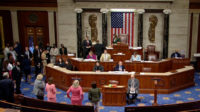Semiconductor chip producers must pay their construction workforce prevailing wages and will be “strongly encouraged” to use project labor agreements if they want a piece of the $39 billion available in federal funding to support fabrication plant construction, expansion or modernization projects, U.S. Commerce Secretary Gina Raimondo says.
The Commerce Dept. CHIPS Program Office released its first notice of funding opportunity Feb. 28 for projects that will boost domestic production of advanced chips used in a wide variety of consumer and military applications. It plans to provide a mix of grants, federal loans and federal guarantees of third-party loans. Direct funding awards are set to range from 5% to15% of project capital expenditures, according to department official who briefed reporters on the program. Applications will be accepted on a rolling basis starting March 31 for some types of chip plants, known as “fabs.”
The goal is to bolster the creation of at least two large clusters of “leading-edge” fabs, Commerce officials say. Currently, no U.S.-based plants produce the most advanced chips, they add. Officials plan to first focus on larger projects that would have greater consequences for economic and national security. Two future rounds of funding are expected. One, late this spring, would be made available to projects to build facilities that supply fabs. The other round, in the fall, would go toward research and development facilities.
Companies seeking funding through the program need to meet a series of requirements, which include providing a construction workforce plan, Raimondo says. That would include an outline of how they plan to recruit, hire, train and retain a skilled construction workforce. A prevailing wage requirement was included in the Chips and Science Act that provided this funding.
Additionally, a Commerce official says it believes project labor agreements would be effective, because of the scale and complexity of the fab projects, in keeping work on schedule and avoiding work stoppages. Any applicant that does not commit to using labor agreements will need to submit a construction workforce continuity plan to demonstrate exactly how it would ensure projects stay on schedule.
Raimondo had recently addressed the need to train more skilled construction workers to build fabs, during a speech about the Chips and Science Act at Georgetown University. Industry groups had mixed responses, with the Associated General Contractors of America calling for more funding for career and technical education programs, and the Associated Builders and Contractors criticizing the costs of requiring prevailing wage.
Commerce would ask applicants to conduct outreach to women for construction jobs as part of the Million Women in Construction initiative Raimondo launched last November. Construction workforce plans also must identify “existing programs that successfully train diverse populations and that can be scaled appropriately, including high-quality apprenticeship readiness programs and registered apprenticeships,” department documents state.
Funding recipients that request more than $150 million in direct funding also must submit plans to provide construction and facility workers with access to affordable, reliable and high-quality child care, Commerce officials announced.
“We need more people in the labor force,” Raimondo says. “We right now lack affordable child care, which is the single most significant factor keeping people, especially women, out of the labor force. We need to see how these companies are going to be meeting their labor force needs.”
Some projects that will likely seek federal funding through the program are already under construction.
Last summer, an Intel Corp. spokesperson told ENR that work on its $20-billion project in New Albany, Ohio, could be delayed if Congress did not pass the Chips and Science Act. Work started on the first phase of its project in September, the month after President Joe Biden signed the legislation. Raimondo also had previously warned that a $5-billion GlobalWafers project in Sherman, Texas, likely relied on receiving the subsidies. Work started on that project in December.
“Companies are going to have to show us why these projects wouldn't be possible without government investment,” Raimondo says. “Each award is going to be negotiated on its own merits and its own terms, and we plan to ensure applicants provide a justification for every dollar of government funds.”






Post a comment to this article
Report Abusive Comment